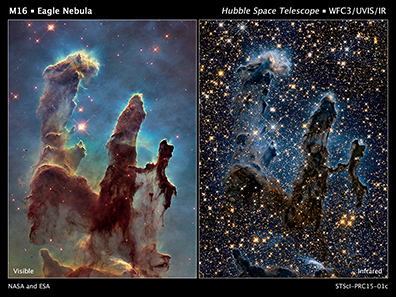Orbiting above the blurring and absorbing effects of Earth's atmosphere, NASA's Hubble Space Telescope (HST) has spent decades recording hundreds of thousands of high-resolution images in ultraviolet, visible and infrared wavelengths. One of the world's most respected scientific instruments, its observations of distant stars, redshifted galaxies, black holes, exoplanets, and other interstellar medium revolutionised humanity's understanding of the universe.
The Hubble Space Telescope is a consummation of a masterpiece of engineering because many of the things that the Hubble did and continues to do were miracles of engineering that did not exist before. Hubble expanded our horizons of thinking with an engineering solution that changed the way we viewed space. […] It connects other galaxies to suns, to planetary systems that we can indirectly sense. All that took a space telescope to do, and it had to be a good one. Hubble discovered things that are now fundamental in the astrophysics of our universe. But the millions of engineering solutions that let it work, they're beyond words. They're magic.
- Jim Garvin, NASA Goddard Chief Scientist

Launched in 1990, Hubble was one of the first space telescopes designed to be repaired and upgraded to extend its life as a premier and highly productive observatory. During the 2009 STS-125 Servicing Mission, astronauts replaced the Wide Field Camera 2 (WFC2) with the Wide Field Camera 3 (WFC3), increasing resolution by six times and expanding the field of view. These improvements alleviated some of the challenges for scientists having to compromise between taking a detailed image of a specific target or trying to capture a wider perspective at a lower resolution.
WFC3 also introduced the capability for capturing images in infrared and ultraviolet light channels. This enabled astronomers to look at objects that emit very little or no visible light and peer through interstellar dust clouds to reveal previously hidden stars and other objects of interest. Infrared imaging is particularly important for looking at extremely distant objects that have redshifted outside the visible spectrum enabling astronomers to trace the evolution of distant galaxies backwards in time and help understand how galaxies form.

For example, HST observed protoplanetary disks; clumps of gas and dust around young stars that likely function as birthing grounds for new planets. One of the most famous is the Eagle Nebula (M16) or “Pillars of Creation".
Hubble's WFC3 instrument is configured with two imaging channels that can be used separately or in unison: an ultraviolet-visible (UVIS) channel and a near-infrared (NIR) channel, meaning it can produce panchromatic images across a wide wavelength range from 200 to 1700 nm.
The UVIS channel uses two full-frame CCD43-82 detectors, each with 4096 columns x 2051 rows and 15x15 µm square pixels and are back-thinned and back-side illuminated for improved sensitivity. The NIR channel uses an H1R mercury, cadmium and tellurium (HgCdTe) sensor array with 1024 rows x 1024 columns and 18x18 µm square pixels. The IR detector is substrate-removed for increased sensitivity, and features an anti-reflection coating optimised for infrared sensitivity.
The IR detector also allows the accumulated signal in each pixel to be measured non-destructively multiple times, which can significantly reduce the effective readout noise. Non-destructive readout also allows for the recovery of pixels affected by cosmic rays because cosmic ray events can be recognised and removed between adjacent reads.
An important innovation in the WFC3 helps prevent the sensor from heating up, which can negatively affect the image quality. The detectors are packaged inside a cold enclosure with a second cooled window to reduce the radiative heat load. Essentially, it is designed to reject wavelengths of light longer than 1700 nm – i.e. “heat". This allows the WFC3 to use an electric cooling device rather than a traditional cryogen-based coolant, greatly simplifying the design and extending the operational life.

With each successive generation of improved scientific instruments – such as adding ultraviolet detection – Hubble reimaged areas of the sky creating gigantic mosaics of deep field images. The latest iteration, Hubble Legacy Field, combines 7,500 separate HST exposures representing 16 years of observations. It contains roughly 265,000 galaxies stretching back 13.3 billion years to just 435 million years after the Big Bang. In other words, it's the closest equivalent we have to a snapshot of the universe.
Part of what enables Hubble to image such distant objects comes from yet another groundbreaking technique developed by scientists. Immense clusters of galaxies located deep in space have been found to create an effect like a magnifying glass called a cosmic or gravitational lens. The enormous gravity of these clusters warps the light from even more distant galaxies beyond, bending and magnifying the light until those galaxies – too faint to be seen directly – become visible.
Other notable achievements:
- Determined the age of the universe to be about 13.8 billion years, more accurate than the older estimated range of between 10 to 20 billion years.
- Discovered Pluto's fifth moon
- Observed water vapour plumes rising above the frigid south polar region of Jupiter's moon Europa.
- Captured images of a never-before-seen breakup of an asteroid.
- Revealed that Jupiter's Great Red Spot is shrinking.
- Determined the size of the largest comet nucleus ever seen.
- Detected the first occurrence of water vapour in an exoplanet's atmosphere orbiting within its star's "habitable zone".
- Successfully predicted the appearance of a supernova explosion.
- Produced the first images of light from a source of gravitational waves.
Hubble continues to serve as an essential catalyst for space exploration and research, serving as an instrument for the entire astronomical community. Any astronomer in the world can submit a proposal and request time on the telescope — alone or in coordination with other observatories in space and on the ground — and for support in using Hubble's extensive data archives.
